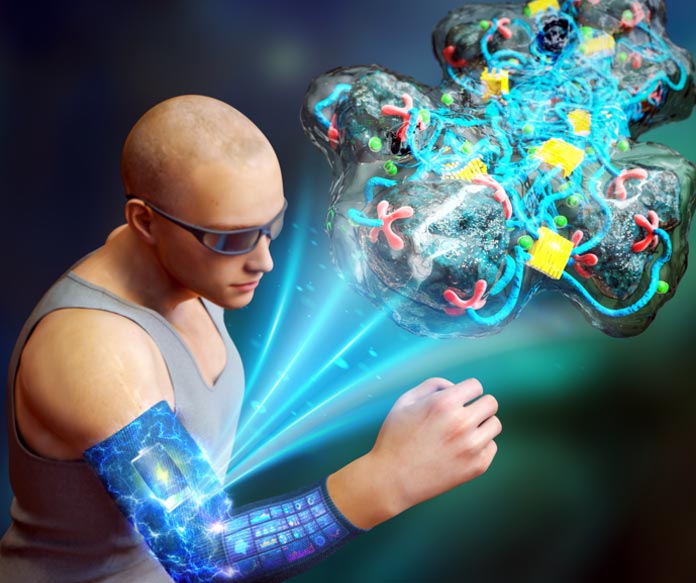Development of stretchable and printable free-form lithium-ion batteries

Graphic image of the research
Credit: Korea Institute of Science and Technology(KIST)
Realization of stretchable, adhesive, and mechanically deformable batteries that effectively transfer ions. Every component was designed to be stretchable to enable printing on clothing and use in wearable devices.
A Korean research team has developed a soft, mechanically deformable, and stretchable lithium battery which can be used in the development of wearable devices, and examined the battery’s feasibility by printing them on clothing surfaces. The research team, led by Dr. Jeong Gon Son from the Soft Hybrid Materials Research Center at the Korea Institute of Science and Technology (KIST; President: Seok-Jin Yoon), announced that they had developed a lithium battery wherein all of the materials, including the anode, cathode, current collector, electrolytes, and encapsulant, are stretchable and printable. The lithium battery developed by the team possesses high capacity and free-form characteristics suitable for mechanical deformation.
Owing to the rapidly increasing demand for high-performance wearable devices such as smart bands, implantable electronic devices such as pace-makers, and soft wearable devices for use in the realistic metaverse, the development of a battery that is soft and stretchable like the human skin and organs has been attracting interest.
The hard inorganic electrode of a conventional battery comprises the majority of the battery’s volume, making it difficult to stretch. Other components, such as the separator and the current collector for drawing and transferring charges, must also be stretchable, and the liquid electrolyte leakage issue must also be resolved.
To enhance stretchability, the research team avoided using materials as had been done in other studies which were unnecessary for energy storage, such as rubber. Then, a new soft and stretchable organic gel material was developed and applied based on the existing binder material. This material firmly holds the active electrode materials in place and facilitates the transfer of ions. In addition, a conductive ink was fabricated using a material with excellent stretchability and gas barrier properties to serve as as a current collector material that transfers electrons and an encapsulant which can function stably even at a high voltage and in various deformed states without swelling due to electrolyte absorption.
The battery developed by the team is also able to incorporate existing lithium-ion battery materials, as they exhibit excellent energy storage density (~2.8 mWh/cm2) of a level similar to that of commercially available hard lithium-ion batteries at a driving voltage of 3.3 V or higher. All of the constituent components of the team’s stretchable lithium-ion battery possess the mechanical stability to maintain their performance even after repeated pulling of the battery 1,000 or more times, a high stretchability of 50% or above, and long-term stability in air.
Moreover, the research team directly printed the electrode and current collector materials which they had developed on either side of an arm warmer made of spandex and applied a stretchable encapsulant to the material, demonstrating the ability to print a stretchable high-voltage organic battery directly on clothing. Using the resulting battery, the research team was able to continuously power a smart watch even when it was being put on, taken off, or stretched.
Dr. Son at KIST stated that his team has developed a stretchable lithium-ion battery technology which provides both structural freedom as a result of the battery’s free-form configuration allowing for it to be printed on materials such as fabrics, and material freedom due to being able to use existing lithium-ion battery materials, in addition to stretch stability which allows for high energy density and mechanical deformation. He also stated that the stretchable energy storage system developed by his team is expected to be applicable to the development of various wearable or body-attachable devices.
This study was supported by the Mid-Career Research Program of the National Research Foundation of Korea, and the KIST Institutional Program and K-Lab Program funded by the Ministry of Science and ICT (Minister: Hye-Sook Lim). The research results were published in ACS Nano (IF: 15.881).
Journal: ACS Nano
DOI: 10.1021/acsnano.1c08405
Article Title: Intrinsically Stretchable and Printable Lithium-Ion Battery for Free-Form Configuration
Article Publication Date: 22-Feb-2022
Media Contact
Young Mi Kim
National Research Council of Science & Technology
ymkim@nst.re.kr
Office: 82-442-877-376
Expert Contacts
Dr. Son, Jeong Gon
Korea Institute of Science and Technology
jgson@kist.re.kr
Office: +82-2-958-5317
Lee, Yeeun (PR Department)
Korea Institute of Science and Technology
yeeun.lee@kist.re.kr
Office: +82-2-958-6929
All latest news from the category: Materials Sciences
Materials management deals with the research, development, manufacturing and processing of raw and industrial materials. Key aspects here are biological and medical issues, which play an increasingly important role in this field.
innovations-report offers in-depth articles related to the development and application of materials and the structure and properties of new materials.
Newest articles

Innovative 3D printed scaffolds offer new hope for bone healing
Researchers at the Institute for Bioengineering of Catalonia have developed novel 3D printed PLA-CaP scaffolds that promote blood vessel formation, ensuring better healing and regeneration of bone tissue. Bone is…

The surprising role of gut infection in Alzheimer’s disease
ASU- and Banner Alzheimer’s Institute-led study implicates link between a common virus and the disease, which travels from the gut to the brain and may be a target for antiviral…

Molecular gardening: New enzymes discovered for protein modification pruning
How deubiquitinases USP53 and USP54 cleave long polyubiquitin chains and how the former is linked to liver disease in children. Deubiquitinases (DUBs) are enzymes used by cells to trim protein…



